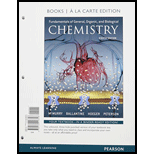
Interpretation:
The electron dot symbol should be drawn for the group 3A.
Concept introduction:
Electron-dot (Lewis) symbol: The numbers of valence electron are shown using dot symbol around the atomic symbol.
The valance electrons are represented as a dot; the dots are distributed around the four sides of the element symbol. Primarily, fill electrons in each side of the atomic symbol, if the element has five or more than five electrons, the electrons are added in the four sides of the element symbol then it will get paired. The maximum dot of the electron in one side of the element symbol is two.
A group of 1A atom has a single dot, a group of 2A atom has two dots and a group of 3A atom has three dots and so on.
Want to see the full answer?
Check out a sample textbook solution
Chapter 2 Solutions
Fundamentals of General, Organic, and Biological Chemistry, Books a la Carte Plus Mastering Chemistry with Pearson eText -- Access Card Package (8th Edition)
- Element Z forms an ion Z 3+, which contains 31 protons. What is the identity of Z, and how many electrons does Z3+have?arrow_forwardDraw Lewis structures for two compounds of formula C2H7N.arrow_forwardIf one compound has the formula C5H10 and another has the formula C4H10, are the two compounds isomers? Explain.arrow_forward
- When pentane is exposed to Br2 in the presence of light, a halogenation reaction occurs. Write the formulas of:(a) All possible products containing only one bromine(b) All possible products containing two bromines that are not on the same carbonarrow_forwardConsider the following acids and their ionization constant, determine which conjugate base is HCOOH Ka = 1.7 x 10-4 (b) HCN Ka = 4.9 x 10-10arrow_forwardDraw a structure for the compound, C3H5Br, that fits the following 1H NMR data: δ 2.32 (3H, singlet) δ 5.35 (1H, broad singlet) δ 5.54 (1H, broad singlet)arrow_forward
- If the phosphorus atom in 3-phosphoglycerate is radioactively labeled, where will the label be when the reaction that forms 2-phosphoglycerate is over?arrow_forwardWrite the chemical formula of the conjugate base of boric acid.arrow_forwardWrite the nuclear equation for the beta decay of Bi-214.arrow_forward
- You simply need to draw all the diagrams of both kinds (Bohr and Lewis) for the first 20 elements.arrow_forwardDetermine the mass in grams of 2.10 × 10²¹ atoms of copper. (The mass of one mole of copper is 63.55 g.)arrow_forwardThe following 'H NMR and IR spectra are obtained for an unknown compound with an empirical formula of C3H1403. Using the information given, determine the structure of the unknown compound. Show all details in your answer. a) 100 %T 88 20 35ee 3eee 25ee 2e0e 1see 1e00 cm1 2H зн 3H 2H 2H 2H 4.5 4.0 3.5 3.0 2.5 2.0 1.5 1.0 PPM 2878. 16 1716. 08 1234.60 1157.44 BE'T6 882.49arrow_forward
 Principles Of Radiographic Imaging: An Art And A ...Health & NutritionISBN:9781337711067Author:Richard R. Carlton, Arlene M. Adler, Vesna BalacPublisher:Cengage Learning
Principles Of Radiographic Imaging: An Art And A ...Health & NutritionISBN:9781337711067Author:Richard R. Carlton, Arlene M. Adler, Vesna BalacPublisher:Cengage Learning

